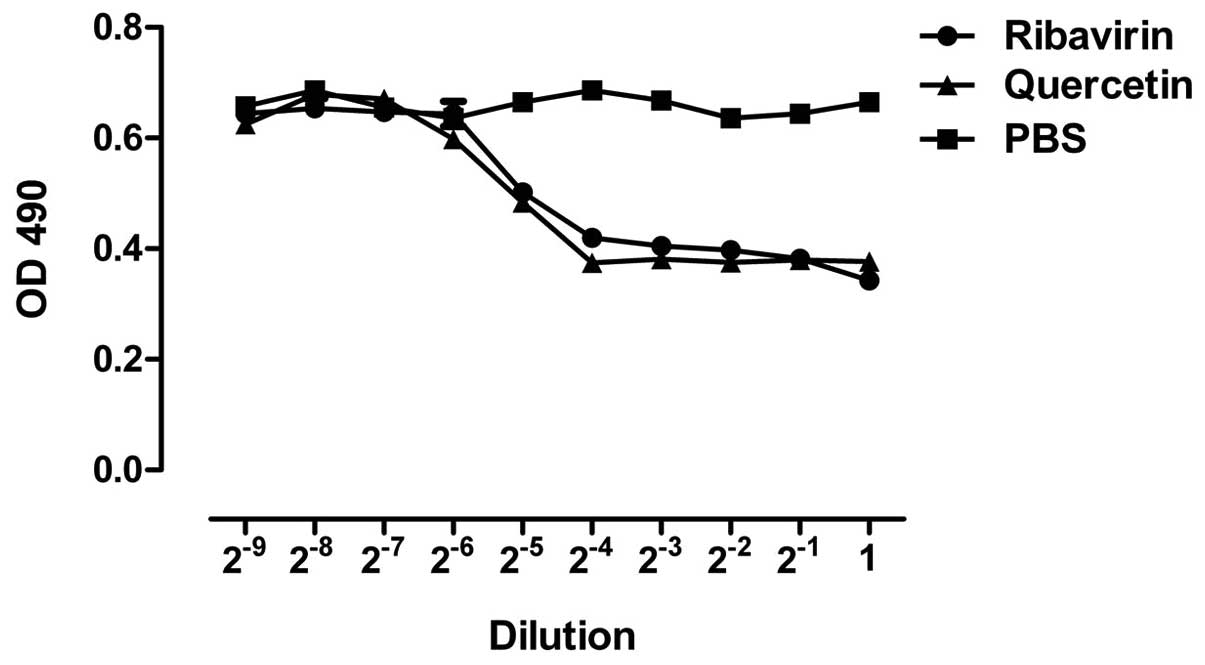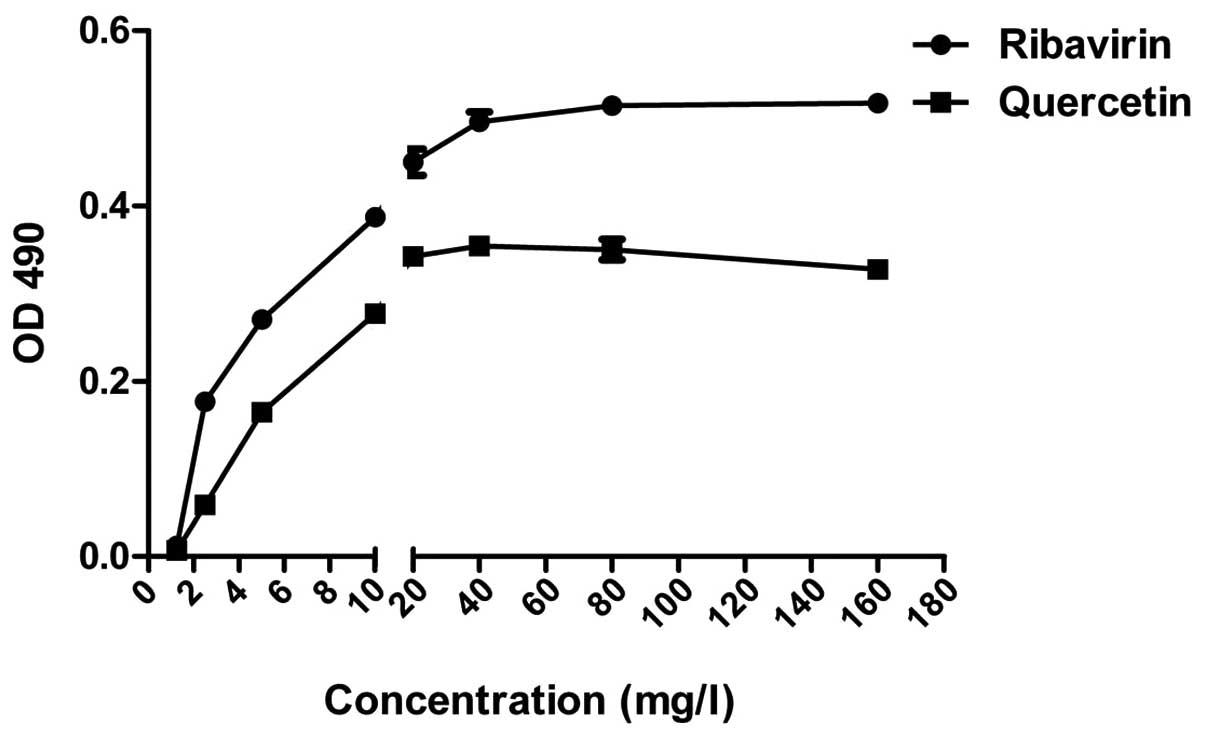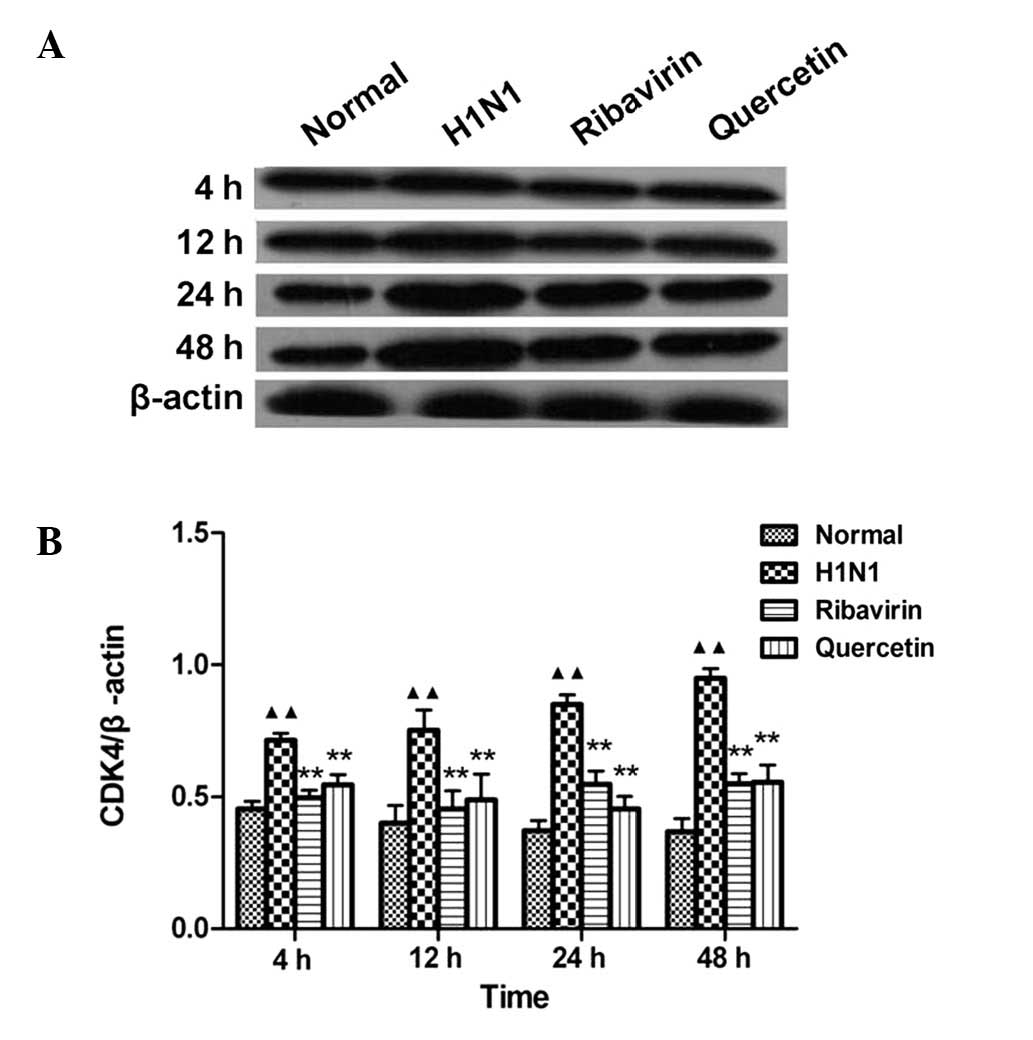Effects of quercetin on CDK4 mRNA and protein expression in A549 cells infected by H1N1
- Authors:
- Published online on: July 19, 2013 https://doi.org/10.3892/br.2013.141
- Pages: 766-770
Abstract
Introduction
Influenza is an acute respiratory disease, with high morbidity and mortality rates in humans and animals (1–2). It has become one of the major diseases worldwide, with a significant impact on the health of the general population and the national economy. The influenza A virus is prone to antigenic drift or antigenic conversion and reorganization of the genome, which leads to the emergence of new subtypes and lack of immunity in the majority of the population. The currently available western medicinal options for the prevention and treatment of influenza A virus infection are accompanied by relatively severe side effects and development of drug resistance with their wide range of applications. Furthermore, the vaccines against the new influenza A virus are ineffective. Therefore, effective anti-influenza drugs used in Chinese medicine should be considered. Chinese medicine enhances the immunity against influenza virus infection, mainly by regulating the immune system (3).
Previous studies demonstrated that quercetin possesses significant antitumor, anti-inflammatory, antioxidant and other biological properties (4,5). Several previous studies demonstrated that quercetin directly interacts with different types of viruses, reducing their infective potential (6,7). It was previously reported that quercetin interfered with the gene signals that enable hepatitis C virus production, indicating that quercetin may allow for dissection of the viral life cycle and has potential therapeutic use by reducing virus production with low-associated toxicity (8). Another study demonstrated that quercetin may reduce influenza A viral replication by directly interacting with viral particles (9). It was also previously reported that quercetin significantly boosted the respiratory antioxidant defense system in mice exposed to influenza A, providing significant protection for the lungs under high-stress conditions (10).
A previous study by Zhang et al(11) reported that overexpression of cyclin-dependent kinase (CDK4) was statistically significant in Epstein-Barr virus-associated nasopharyngeal carcinoma tissues compared to non-cancerous nasopharyngeal epithelial tissues (P<0.05) by quantitative reverse-transcription polymerase chain reaction (RT-PCR) and tissue microarray.
At present, there are no studies available on the antagonizing action of quercetin towards the CDK4 induction caused by H1N1 influenza virus. The aim of this study was to investigate the effect of quercetin on the expression of CDK4 mRNA and protein in H1N1-infected A549 cells, elucidate the mechanism underlying the anti-influenza action of quercetin and provide experimental evidence that may lead to the development of novel anti-influenza drugs.
Materials and methods
Virus and cells
Influenza A H1N1 (A1/Qian fang/166/85), was provided by the Chinese Academy of Traditional Chinese Medicine and stored at −75°C in the laboratory with the hemagglutination titer virus stock solution of 2−7. The A549 human lung epithelial cell line was purchased from the Cell Culture Center of Peking Union Medical College and cultured prior to use.
Drugs
Quercetin (lot no. 100081-200907, purchased from The Control of Pharmaceutical and Biological Products, Beijing; HPLC purity 96.5%), was stored in incomplete DMEM containing 1/1000 dimethyl sulfoxide (DMSO) to create a 2-g/l stock. Ribavirin particles (lot no. 100725, Sichuan Baili Pharmaceutical Co., Ltd., Sichuan, China), were stored in incomplete DMEM to create a 10-g/l stock. The drugs mentioned above were filtered through a 0.22-μm Millipore filter (Millipore, Billerica, MA, USA), packaged and stored at 4°C.
Reagents
The reagents used are listed below: fetal calf serum (Hyclone, Logan, UT, USA), DMEM and 0.25% trypsin digestion solution (Neuron Biotech Co., Ltd), Thiazolyl Blue Tetrazolium Bromide (MTT) and DMSO (Sigma, St. Louis, MO, USA), TRIzol kit (Invitrogen, Carlsbad, CA, USA), M-MLV reverse transcription kit (Takara Bio, Inc., Shiga, Japan), qPCR amplification kit (Beijing Zeping Bioscience & Technologies Co., Ltd., Beijing, China), SYBR-Green PCR mix (Bio-Rad, Hercules, CA, USA; cat no.: 170-8880, lot no.: 20220B), agarose (Promega, Madison, WI, USA), diethyl pyrocarbonate (DEPC, Sigma), cell lysis buffer (Beyotime, Nanjing, China), CDK4 primary antibody (Millipore; cat no.: MAB8879, lot no.: NG1753071), mouse anti-human β-actin (Boshide Bioengineering Co., Ltd., Wuhan, China; cat no.: BM0627) and goat anti-mouse IgG secondary antibody (Beijing Zhongshan Golden Bridge BioTecnology Co., Ltd., Beijing, China; cat no.: ZB-2305 lot no.: 92580). The western blot analysis reagents were prepared in the laboratory. The PCR primer sequences were synthesized by Shanghai Sangon Biological Engineering Technology and Service Co., Ltd., Shanghai, China, and were as follows: CDK4 (154 bp): F: 5′-CACCCGTGGTTGTTACACTC-3′ and R: 5′-AACTGGTCGGCTTCAGAGTT-3′; GAPDH (143 bp): F: 5′-GGGTGTGAACCATGAGAAGT-3′ and R: 5′-GGCATGGACTGTGGTCATGA-3′.
Main equipment
The equipment used is listed below: ABI 7500 Real-Time PCR instrument (Applied Biosystems, Foster City, CA, USA), Steady Current and Voltage Electrophoresis system (Bio-Rad), Gel Imaging Analysis System BINTA 2020D (Beijing BINTA Instrument Technology Co., Ltd., Beijing, China), Graphic Image Analyzer (Image-Pro Plus Analysis Software 6.0), Low-Temperature High-Speed Centrifuge Series (Thermo Fisher Scientific, West Palm Beach, FL, USA), Sartorius BS224S electronic scale (Sartorius, Goettingen, Germany), BioPhotometer nucleic acid UV spectrophotometer (Eppendorf, Hamburg, Germany), Vertical Electrophoresis slot (Bio-Rad) and Trans-Blot SD Semi-Dry Electrophoretic Transfer Cell (Bio-Rad).
Determination of H1N1 virulence
A549 cells were digested with 0.25% trypsin solution, adjusted to 3×105 cells/ml, transferred into a 96-well cell culture plate (100 μl per well), incubated at 37°C in a 5% CO2 incubator until cells grew into a monolayer and the liquid medium was discarded. H1N1 was diluted to 10 concentrations by a 10X gradient with a maintenance medium, using 4 wells per concentration and 100 μl per well. An additional 4 wells were used as the normal control group (without addition of virus) and the cells were cultured for 3 days at 37°C in a 5% CO2 incubator. The cultures were observed daily, cell lesions were determined by MTT and the TCID50 was calculated according to the Reed-Muench formula (12).
Determination of quercetin and ribavirin cytotoxicity
A total of 3×105 cells/ml were placed in 96-well plates, discarding the liquid medium in the well when the cells grew into a monolayer. The drugs were diluted to 10 concentrations by a 2X gradient with a complete DMEM medium, using 4 wells per concentration and 100 μl per well. An additional 4 wells were used as the normal control group, cultured in a 37°C, 5% CO2 incubator for 2 days. Drug cytotoxicity was determined by MTT. The drug concentration in which the cell survival rate was >50% was defined as the maximum non-toxic concentration (TC0).
Inhibitory action of quercetin on A549 lesions induced by H1N1
A total of 3×105 cells/ml were placed in 96-well plates and the liquid medium in the well was discarded when the cells grew into a monolayer. After exposing the cells to 100 TCID50 for 2 h, the virus solution was removed and the cells were washed twice with PBS. The drugs were diluted from 160 mg/l to 10 concentrations by a 2X gradient with a cell maintenance medium, using 4 wells per concentration and 100 μl per well, with established normal control and H1N1 groups (4 wells per group), cultured in a 37°C, 5% CO2 incubator for 2 days. The inhibitory action of quercetin on the A549 lesions induced by H1N1 was determined by MTT.
Grouping and treatment of A549 cells
A549 cells at a concentration of 2×105/ml were placed in 96 Petri dishes (diameter 60-mm), including the normal control, H1N1, ribavirin-positive control and quercetin-treated groups, using 6 dishes per group (3 dishes for RNA extraction and the remaining 3 for protein analysis), setting 4 time points (4, 12, 24 and 48 h).
The excess fluid in the wells was discarded when the cells grew into a monolayer and the cells were washed twice with PBS. After exposing the cells to 100 TCID50 for 2 h (except for the normal group), the virus solution was discarded. Maintenance medium (4 ml) was added to the normal control and H1N1 groups; maintenance medium (4 ml) containing 20 mg/l ribavirin was added to the ribavirin group; maintenance medium (4 ml) containing 10 mg/l quercetin was added to the quercetin group.
mRNA assay of CDK4 by fluorescent qPCR
The Petri dishes were removed at each time point and the cells were washed twice with PBS, followed by the addition of 1 ml TRIzol to every dish and mixing the cell mixture by pipetting up and down several times. The cells were incubated for 10 min at room temperature and the total RNA was extracted according to the method described by Deng et al(13).
The reverse transcription system (25 μl) was as follows: 3 μl RNA, 1 μl oligo(dT), 5 μl 5X buffer, 5 μl dNTP (10 mM), 0.5 μl RNAse inhibitor, 1 μl M-MLV and 9.5 μl ddH2O. The mixture was incubated at 42°C for 60 min and then at 70°C for 10 min. The fluorescent qPCR system (20 μl) was as follows: 1.5 μl cDNA, 0.5 μl primers F (10 pmol/μl), 0.5 μl primers R (10 pmol/μl), 10 μl SYBR-Green mix and 7.5 μl ddH2O. The qPCR conditions were as follows: pre-denaturation at 94°C for 15 min, denaturation at 94°C for 15 sec, annealing at 60°C for 34 sec, extension at 72°C for 15 sec and, after a total of 40 cycles, extension at 72°C for 10 min.
Protein assay of CDK4 by western blot analysis
The Petri dishes were removed at each time point, the cells were washed twice with PBS and 600 μl of cell lysate solution was added to each dish, followed by continued lysis on ice for 15 min. The cell lysate was collected in EP tubes (1.5 ml) and centrifuged at 10,000 × g for 10 min at 4°C. The supernatant was then transferred to a new EP tube. Western blot analysis was performed following determination of the protein concentration by the Bradford method.
Statistical analysis
The CDK4 and β-actin gray values were measured using Image-Pro Plus 6.0 software and the ratio of gray value was relative to the protein expression level. Experimental data were statistically analyzed by SPSS software, version 13.0. The two groups were compared by t-test and data are presented as mean ± standard error. P≤0.05 was considered to indicate a statistically significant difference.
Results
H1N1 virulence
Following infection of A549 cells with H1N1 for 48 h, the cells of the normal control group appeared to be in good condition when observed under the inverted microscope. Compared to the normal control group, the cells of the virus group appeared to be rounder, smaller and detached from the sidewalls; the intercellular connections were broken or had disappeared, demonstrating the cytopathic effect (Fig. 1A). According to MTT and the Reed-Muench formula, the TCID50 of H1N1 (A1/Qianfang/166/85) on A549 cells was 10−4.75 (Fig. 1B).
Cytotoxicity of quercetin and ribavirin
Following culture for 48 h with 3 repetitions, according to MTT, the TC0 of quercetin and ribavirin on A549 cells was calculated to be 30–60 and 150–300 mg/l, respectively (Fig. 2).
Inhibitory effects of quercetin on A549 cell lesions induced by H1N1
The cell shape and size and the number of cells adherent to the sidewalls in the quercetin groups (80, 40, 20 and 10 mg/l) were better compared to those in the H1N1 and the ribavirin groups (160, 80, 40 and 20 mg/l) and were similar to those of the normal group (Fig. 3). The minimum effective concentration of quercetin and ribavirin on A549 cell lesions induced by H1N1 were 10 and 20 mg/l, respectively.
Effects of quercetin on CDK4 mRNA expression
The method described by Livak and Schmittgen (14) was used to assess the effects of quercetin on CDK4 mRNA expression and the results are presented in Table I. Compared to the normal control group, mRNA expression in the H1N1 groups was significantly higher (P<0.01) at all 4 time points (4, 12, 24 and 48 h), which indicated that H1N1 infection may induce the expression of CDK4 mRNA in A549 cells. Compared to the H1N1 groups, CDK4 mRNA expression in the ribavirin and the quercetin groups was significantly lower (P<0.01) at 4 treatment time points (2, 10, 22 and 46 h), indicating that CDK4 mRNA expression in A549 cells infected with H1N1 within 48 h may be inhibited by quercetin (10 mg/l).
Effects of quercetin on CDK4 protein expression
Compared to the normal group, the CDK4 protein expression in the H1N1-infected group was significantly increased (P<0.01) at 4 time points (4, 12, 24 and 48 h), which indicates that H1N1 may induce the expression of CDK4 in A549 cells. Compared to the H1N1 groups, CDK4 protein expression was significantly decreased (P<0.01) at four treatment time points (2, 10, 22 and 46 h) (Fig. 4B). This result indicates that CDK4 expression in A549 cells infected by H1N1 within 48 h may be inhibited by quercetin (10 mg/l).
Discussion
Influenza is an acute respiratory infectious disease. The epithelial cells of the respiratory tract are a vulnerable target for H1N1. Based on the different characteristics of H1N1 proliferation in different cell lines in vitro, the A549 human lung cancer epithelial cell line was selected to conduct this experiment.
The eukaryotic cell cycle is under the control of precise and complex protective regulatory mechanisms and consists of four distinct phases: G1, S (synthesis), G2 and M (mitosis). Several factors, such as the cyclin/cyclin-dependent kinase (cyclin/CDK) complex, closely regulate all the processes of each phase (15). If cell proliferation is disturbed by infection with the influenza A virus, the host cells are arrested in the G0/G1 phase (16) and if the DNA damage is not repaired, the cells enter the apoptotic process (17).
The results of this study have demonstrated that the CDK4 mRNA and protein expression was significantly increased in the H1N1 group (P<0.01) at four time points (4, 12, 24 and 48 h). However, CDK4 expression was significantly decreased in the quercetin-treated group (P<0.01) at four treatment time points (2, 10, 22 and 46 h). It is possible that quercetin in A549 cells infected with H1N1 within 48 h is able to induce the DNA repair mechanism, thus contributing to the host cell proliferation. However, additional studies are required to support this hypothesis. This study has demonstrated that, although the direct antiviral effect of quercetin on H1N1 was not as potent as that of ribavirin, it was less toxic and acted by inhibiting the mRNA and protein expression of CDK4 induced by H1N1 infection. Therefore, it is concluded that quercetin possesses a potential antiviral clinical application value, although further investigations are required to elucidate the mechanism of action and time limit of quercetin on H1N1-infected cells.
Acknowledgements
This study was funded by the Special Talents Project of Ningxia Medical University (XT 2012004) and the Provincial Project (NGY 2012067).
References
|
Fraser C, Donnelly CA, Cauchemez S and Hanage WP: Pandemic potential of a strain of influenza A (H1N1): early findings. Science. 324:1557–1561. 2009. View Article : Google Scholar : PubMed/NCBI | |
|
Romanowska M, Stefanska I, Donevski S and Brydak LB: Infections with A(H1N1)2009 influenza virus in Poland during the last pandemic: experience of the National Influenza Center. Adv Exp Med Biol. 756:271–283. 2013. View Article : Google Scholar : PubMed/NCBI | |
|
Sharma U, Bala M, Saini R, et al: Polysaccharide enriched immunomodulatory fractions from Tinospora cordifolia(Willd) miers ax hook. f. & Thoms. Indian J Exp Biol. 50:612–617. 2012.PubMed/NCBI | |
|
Gacche RN, Shegokar HD, Gond DS, Yang Z and Jadhav AD: Evaluation of selected flavonoids as antiangiogenic, anticancer, and radical scavenging agents: an experimental and in silico analysis. Cell Biochem Biophys. 61:651–663. 2011. View Article : Google Scholar : PubMed/NCBI | |
|
Yang W, Ahmed M, Tasawwar B, et al: Combination radiofrequency (RF) ablation and IV liposomal heat shock protein suppression: reduced tumor growth and increased animal endpoint survival in a small animal tumor model. J Control Release. 160:239–244. 2012. View Article : Google Scholar | |
|
Karl TN, Middleton E Jr and Ogra PL: Antiviral effect of flavonoids on human viruses. J Med Virol. 15:71–79. 1985. View Article : Google Scholar | |
|
Ganesan S, Faris AN, Comstock AT, et al: Quercetin inhibits rhinovirus replication in vitro and in vivo. Antiviral Res. 94:258–271. 2012. View Article : Google Scholar : PubMed/NCBI | |
|
Gonzalez O, Fontanes V, Raychaudhuri S, et al: The heat shock protein inhibitor Quercetin attenuates hepatitis C virus production. Hepatology. 50:1756–1764. 2009. View Article : Google Scholar : PubMed/NCBI | |
|
Choi HJ, Song JH and Kwon DH: Quercetin3-rhamnoside exerts antiinfluenza A virus activity in mice. Phytother Res. 26:462–464. 2012.PubMed/NCBI | |
|
Uchide N and Toyoda H: Antioxidant therapy as a potential approach to severe influenza-associated complications. Molecules. 16:2032–2052. 2011. View Article : Google Scholar : PubMed/NCBI | |
|
Zhang W, Zeng Z, Zhou Y, et al: Identification of aberrant cell cycle regulation in Epstein-Barr virus-associated nasopharyngeal carcinoma by cDNA microarray and gene set enrichment analysis. Acta Biochim Biophys Sin (Shanghai). 41:414–428. 2009. View Article : Google Scholar : PubMed/NCBI | |
|
Guo YJ and Chen XW: Influenza virus and its experimental techniques. China Three Gorges Press; Beijing: 1997, pp. 94–96 | |
|
Deng LH, Luo MW, Zhang CF and Zeng HC: Extraction of high-quality RNA from rubber tree leaves. Biosci Biotechnol Biochem. 76:1394–1396. 2012. View Article : Google Scholar : PubMed/NCBI | |
|
Livak KJ and Schmittgen TD: Analysis of relative gene expression data using real-time quantitative PCR and the 2(−Delta Delta C(T)) Method. Methods. 25:402–408. 2001. | |
|
Evan GI and Vousden KH: Proliferation, cell cycle and apoptosis in cancer. Nature. 411:342–348. 2001. View Article : Google Scholar : PubMed/NCBI | |
|
He Y, Xu K, Keiner B, et al: Influenza a virus replication induces cell cycle arrest in G0/G1 phase. J Virol. 84:12832–12840. 2010. View Article : Google Scholar : PubMed/NCBI | |
|
Odell ID, Wallace SS and Pederson DS: Rules of engagement for base excision repair in chromatin. J Cell Physiol. 228:258–266. 2013. View Article : Google Scholar : PubMed/NCBI |













